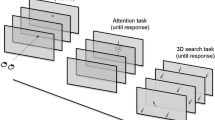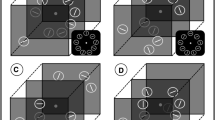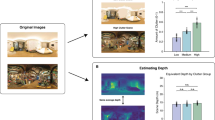Abstract
Research of human-centered computing systems in industry should not avoid advances in visual display technology for safety, warning, and interaction. Novel 3D displays that present information in real depth offer potential benefits. Previous research has studied depth in visual search but depth was mostly not realized by real physical separation. Many areas of Human Factors could be augmented with the study and evaluation for operation of novel 3D displays. Such a study was presented to better understand the effects of real physical depth in association with depth redundantly coded with another feature (an additional mark on a target) distinguishing it from distracters and target location on visual search in a depth display. Target location was studied as the row or column in the visual field of view the target was positioned and also in terms of eccentricity outwardly from the center of the display. In general, depth was found to be of benefit when redundantly coded with another attribute for guiding attention. Targets were not found as fast when the target’s location was further from the center fixation point, and interactions between target distinction (depth, mark, or depth+mark) and target location provide implications for designers.
Similar content being viewed by others
References
Anderson G. J. (1990) Focused attention in three-dimensional space. Perception & Psychophysics 47: 112–120
Anderson G. J., Kramer A. F. (1998) Limits of focused attention in three-dimensional space. Journal of Experimental Psychology: Human Perception and Performance 24: 1476–1485
Bloomfield J. (1972) Visual Search in complex fields: Size differences between target disc and surrounding discs. Human Factor 14: 139–148
Blundell G. B., Schwartz A. J. (2006) Creative 3-D display and interaction interfaces. Wiley, Hoboken, NJ
Bolia, R. S., Nelson, W. T., Gardner, C. M., Vidulich, M. A., & McLaughlin, A. B. (2003). A visual depth display for air battle managers: Effects of depth and transparency on performance and workload. Setting the standards. In Proceedings of the Sixth International Australian Aviation Psychology Symposium. Format: CDROM.
Bolia R. S., Nelson W. T., Middendorf M. S., Guilliams N. M. (2004) Evaluating the utility of a multi-layered visual display for air battle managers. Human Factors and Ergonomics Society Annual Meeting Proceedings 48: 21–25
Bowman D., Kruijff E., Laviolla J.J. Jr., Poupyrev I. (2004) 3D user interfaces: Theory and practice. Addison-Wesley, Reading, MA
Captain, S. (2009). 3-D TV that actually works. In Wired. 22 August 2006. Retrieved 8 March 2009. http://www.wired.com/science/discoveries/news/2006/08/71627.
Cardinal R.N., Aitken M.R. (2005) ANOVA for the behavioral sciences researcher. Taylor and Francis, London
Carrasco M., Chang I. (1995) The interaction of objective and subjective organizations in a localization task. Perception and Psychophyscis 10: 113–129
Carrasco M., Evert D. L., Chang I., Katz S. M. (1995) The eccentricity effect: Target eccentricity affects performance on conjunction searches. Perception & Psychophysics 57: 1241–1261
Cohen J., Cohen P., West S. G., Aiken L. S. (2003) Applied multiple regression/correlation analysis for the behavioral sciences, 3rd edn. Lawrence Erlbaum Associates, Mahwah, NJ
Company Profile. (2009). IGT. In Reuters. 8 March 2009. Retrieved 8 March 2009. http://www.reuters.com/finance/stocks/companyProfile?symbol=IGT.W&rpc=66.
Drascic D., Migram P. (1996) Perceptual issues in augmented reality. Proceedings of SPIE, Stereoscopic Displays and Virtual Reality Systems III 2653: 123–134
Drury C., Clement M. (1978) The effect of area, density, and number of background characters on visual search. Human Factors 20: 597–602
Duncan J., Humphreys G. W. (1989) Visual search and stimulus similarity. Psychological Review 96: 433–458
Efron R., Yund E. W. (1996) Spatial nonuniformities in visual search. Brain and Cognition 31: 331–368
Enoch J. M. (1959) Effects of the size of a complex display upon visual search. Journal of the Optical Society of America 49: 280–286
Erickson R. A. (1964) Relation between visual search time and peripheral visual acuity. Human Factors 6: 165–177
Havig, P. Aleva, D., Reis, G., Moore, J., and McIntire, J. (2007). Metrics for 3D displays. In J. T. Thomas & A. Malloy (Eds.), Display technologies and applications for defense, security, and avionics (Vol. 6558, pp. 65580J). Proceedings of the SPIE.
Howard I. P., Rogers B. J. (1995) Binocular vision and stereopsis. Oxford University Press, New York
Kirk E. (1995) Experimental design: Procedures for the behavioral sciences. Brooks/Cole Publishing Co, Pacific Grove, CA
Krendal E. S., Wodinsky J. (1960) Search in an unstructured visual field. Journal of the Optical Society of America 50: 562–568
Limpert E., Stahel W., Abbt M. (2001) Log-normal distributions across the sciences: Keys and clues. BioScience 51(5): 341–352
Mancero G., Wong W. (2005) An evaluation of perceptual depth to enhance change detection. Human Factors and Ergonomics Society Annual Meeting Proceedings 52: 338–342
Max L., Onghena P. (1999) Some issues in the statistical analysis of completely randomized and repeated measures designs for speech, language, and hearing research. Journal of Speech, Language, and Hearing Research 42: 261–270
Medical holograms give doctors cutting-edge view. In MyFoxChicago. Retrieved 8 March 2009. http://www.myfoxchicago.com/dpp/health/medical_holograms.
Monk T., Brown B. (1975) The effect of target surround density on visual search performance. Human Factors 17: 356–360
Monnier P. (2006) Detection of multidimensional targets in visual search. Vision Research 46: 4083–4090
Mon-Williams M., Wann J. P., Rushton S. (1993) Binocular vision in a virtual world: Visual deficits following the wearing of a head-mounted display. Ophthalmic and Physiological Optics 13: 387–391
Nakayama K., Silverman G. H. (1986) Serial and parallel processing of visual feature conjunctions. Nature 320: 264–265
Ogle K. N. (1950) Researches in binocular vision. Saunders, Philadelphia
O’Toole A. J., Walker C. L. (2008) On the preattentive accessibility of stereoscopic disparity: Evidence from visual search. Perception and Psychophysics 59(2): 202–218
Previc F. H., Blume J. L. (1993) Visual search asymmetries in three-dimensional space. Vision Research 33(18): 2697–2704
PureDepth. (2009). Retrieved 8 March, 2009. http://www.puredepth.com/.
Rawlings S. C., Shipley T. (1959) Stereoscopic acuity and horizontal angular distance from fixation. Journal of the Optical Society of America 59: 991–993
Reardon, M. (2009). 3D is coming to a living room near you. CNN.com/technology. CNN. 15 January 2009. Retrieved 8 March 2009. http://www.cnn.com/2009/TECH/01/15/3d.tv/index.html.
Salvendy, G. (Ed.). (2006). Handbook of human factors and ergonomics (3rd ed.). Hoboken, NJ: Wiley.
Sedgwick H. A. (1986) Space perception. In: Boff K. R., Kaufman L., Thomas J. P. (eds) Handbook of perception and human performance vol. 1. Wiley, New York, pp 2-11–21-57
Treisman A., Gelade G. (1980) A feature integration theory of attention. Cognitive Psychology 12: 97–136
Treisman A., Souther J. (1985) Search asymmetry: A diagnostic for preattentive processing of separable features. Journal Experimental Psychology: General 114(3): 285–310
Wann J. P., Rushton S., Mon-Williams M. (1995) Natural problems for stereoscopic depth perception in virtual environments. Vision Research 35(19): 2731–2736
Wesler, M., Lucas, J., Gallimore, J.J., & Marshak, W.P. (1999). Managing uninhabited ariel vehicle (UAV) employing a reduced area/depth separated display. Human Factors and Ergonomics Society Annual Meeting Proceedings, Aerospace Systems, 43, 91–95.
Williams L. G. (1966) The effect of target specification on objects fixed during visual search. Perception & Psychophysics 1: 315–318
Wolfe J. M. (2007) Guided search 4.0. current progress with a model of visual search. In: Gray W. D. (eds) Integrated models of cognitive systems. Oxford University Press, New York, pp 99–119
Wolfe J. M., Horowitz T. S. (2004) What attributes guide the deployment of visual attention and how do they do it?. Nature Reviews, Neuroscience 5: 495–501
Wolfe J. M., O’Neil P., Bennett S. C. (1998) Why are there eccentricity effects in visual search? Visual and attentional hypotheses. Perception & Psychophysics 60(1): 140–156
Wong B. L. W., Joyekurun R., Nees A., Amaldi P., Villanueva R. (2005) Information layering, depth and transparency effects on multi-layered displays for command and control. Human Factors and Ergonomics Society Annual Meeting Proceedings 49: 352–356
Yonas A., Pittenger J. (1973) Searching for many targets: An analysis f speed and accuracy. Perception & Psychophysics 13: 513–516
Author information
Authors and Affiliations
Corresponding author
Rights and permissions
About this article
Cite this article
Reis, G., Liu, Y., Havig, P. et al. The effects of target location and target distinction on visual search in a depth display. J Intell Manuf 22, 29–41 (2011). https://doi.org/10.1007/s10845-009-0280-z
Received:
Accepted:
Published:
Issue Date:
DOI: https://doi.org/10.1007/s10845-009-0280-z




